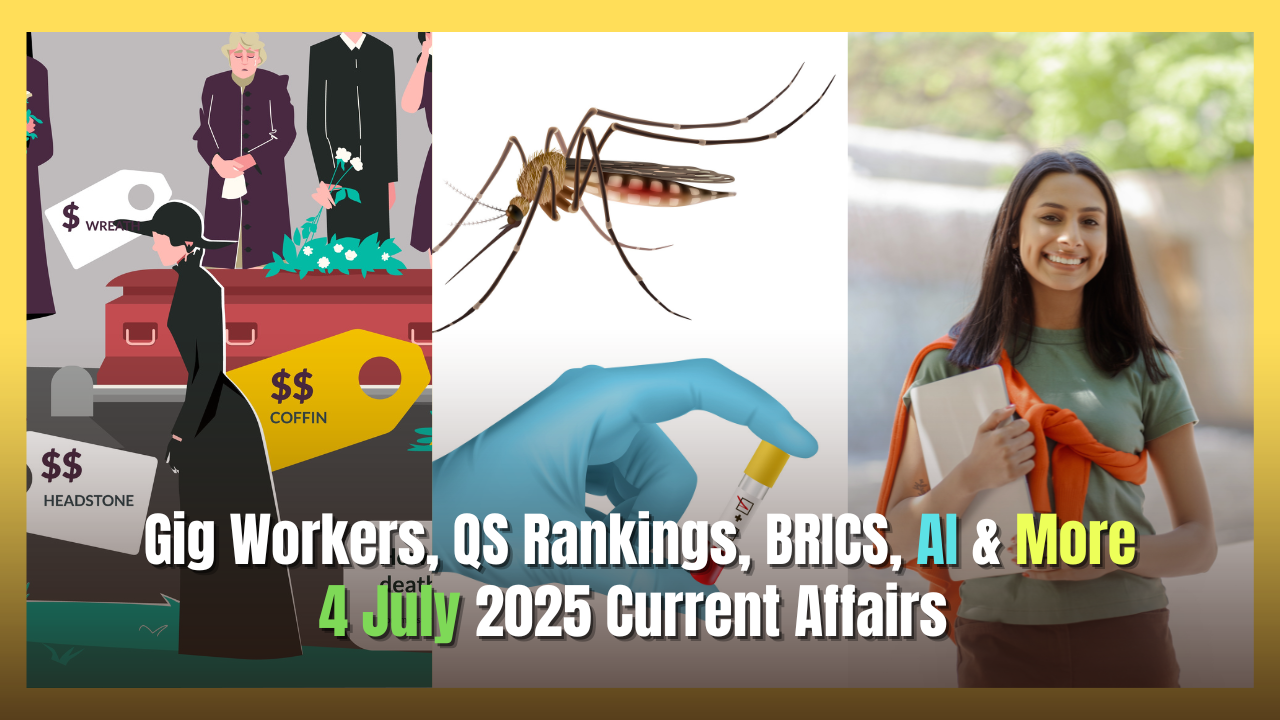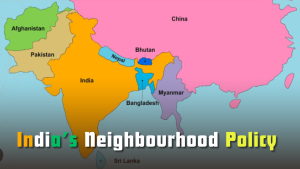Daily Current Affairs 04th July 2025
In today’s edition of current affairs, we bring you the most important national and international updates that matter. From critical discussions on custodial deaths to breakthroughs in vaccine development, here’s a quick overview of the key topics we’re covering today:
-
Custodial Deaths and Policing
-
Are AI Models Built on Stolen Creative Work?
-
Gig Workers Missing from India’s Labour Data
-
How did Indian universities fare on the QS ranking list?
-
BRICS to create a balanced multipolar world order
-
India’s Indigenous Dengue Vaccine, DengiAll
-
Kariyachalli Island
-
C-FLOOD Platform
Stay with us as we dive into each of these stories in detail.
Custodial Deaths and Policing
Context: The recent custodial death of Ajith Kumar, a security guard from Sivaganga district, has reignited public outrage over police brutality in Tamil Nadu.
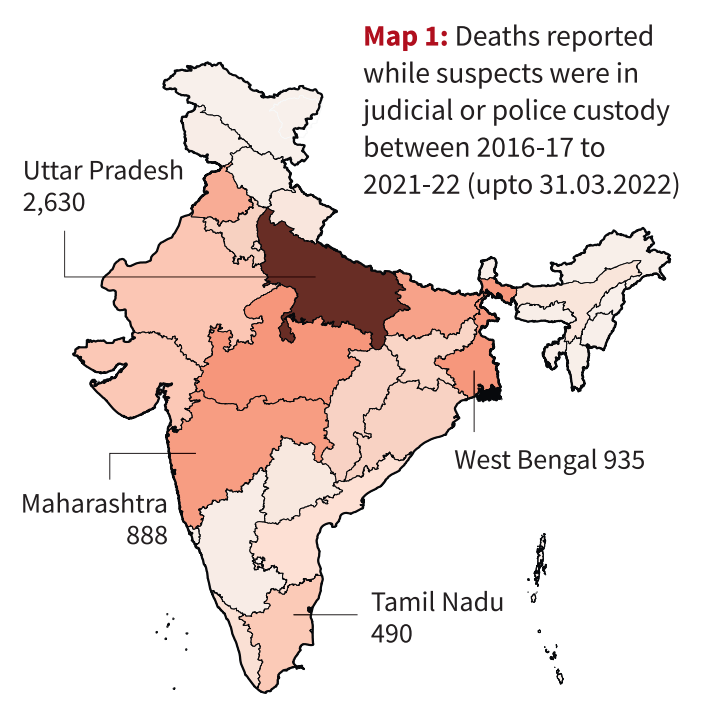
What Are the Main Causes Behind Recurring Custodial Deaths?
- Police often resort to physical abuse during interrogations, leading to serious injuries or death. Notable cases include the Ambasamudram incident in 2023, where detainees were brutally beaten.
- Investigations are slow, and legal action is rare. Most inquiries are internal, with minimal external oversight, leading to delayed or no justice for victims.
- Only a small fraction of cases see magisterial or judicial inquiries. For instance, only 345 such inquiries were initiated out of over 11,000 reported deaths between 2017 and 2022.
- A persistent lack of accountability within the police force allows violations to continue without fear of consequences. Out of 74 human rights violation cases filed against police between 2017 and 2022, only three convictions were secured.
How Are Marginalised Communities, Especially Scheduled Castes, Disproportionately Affected?
- Scheduled Castes (SCs) are detained at much higher rates than their population share, reflecting systemic bias. In Tamil Nadu (2022), SCs accounted for 38.5% of detainees under preventive laws, despite forming only 20% of the state’s population.
- SC communities face discriminatory policing, leading to higher instances of illegal detention and custodial violence, especially under vague or discretionary laws.
What Legal Safeguards Exist Against Custodial Violence?
-
- Legal Provisions: Section 176(1A) of the Criminal Procedure Code (CrPC) mandates judicial inquiry in custodial death cases.
-
Judicial Interventions
-
-
- D.K. Basu Guidelines (1996): Mandate arrest memos, medical examinations, and legal aid for detainees.
- P. Rathinam vs Union of India (1994): Recognised custodial torture as a violation of Article 21 (Right to Life).
- Sathankulam Case (2020): The Madras HC monitored the probe, leading to rare convictions.
-
-
Legislative & Policy Measures
-
- NHRC Guidelines (1993): Require mandatory reporting of custodial deaths within 24 hours.
- Model Police Act, 2006: Proposed police reforms, but few states adopted it.
- CCTNS (Crime and Criminal Tracking Network & Systems): Aims for digital policing transparency, but implementation is weak.
- Police Reforms and Technology Measures: Initiatives include training under the Modernisation of Police Forces (MPF), installation of CCTV cameras in police stations, use of body cameras, and digital evidence collection apps like e-Sakshya.
Why Do Police Convictions Remain Rare Despite Safeguards?
- Most cases are investigated by the police themselves, leading to conflicts of interest and lack of transparency.
- Magisterial inquests and judicial inquiries are often delayed or not completed, and reports may not lead to criminal proceedings.
- The social status of victims’ families can affect the likelihood of action against police personnel, with marginalised groups facing greater hurdles.
- India lacks a dedicated anti-torture law aligned with the UN Convention Against Torture, making it difficult to prosecute cases of custodial violence effectively.
What Is the Way Forward?
- Fast-track pending cases, ensure timely submission of inquiry reports, and hold all ranks of police accountable, including senior officers.
- Increase public awareness about rights in custody and encourage reporting of abuse without fear of reprisal.
- Regularly publish data on custodial deaths, inquiries, and convictions to ensure transparency and public scrutiny.
Are AI Models Built on Stolen Creative Work?
Context: In a significant development for the future of artificial intelligence (AI), two major US court rulings last week sided with tech companies in copyright infringement cases concerning AI model training.
How Do AI Models Use Copyrighted Content for Training?
- Generative AI models such as ChatGPT, Claude, and Gemini work by identifying patterns in enormous datasets—books, images, articles, music, and more—available online.
- Their ability to produce human-like content depends heavily on the volume and diversity of the training data, some of which includes copyrighted materials, often accessed through shadow libraries like Books3, Libgen, or Anna’s Archive.
- While creators argue this constitutes intellectual property theft, tech companies claim that such use falls under the legal principle of “fair use”—particularly if the end product is “transformative” in nature.
Copyright Law in India
Copyright law in India is governed primarily by the Copyright Act, 1957, as amended, which provides comprehensive protection for original works and aligns with international standards. The Act protects the following categories of works: Original literary, dramatic, musical, artistic works, Cinematograph films and Sound recordings. Copyright provides creators with exclusive rights to: Reproduce the work, Distribute copies, Communicate the work to the public, Perform the work publicly, Adapt and translate the work. For computer programs, there are additional rights, such as commercial rental. India is a member of major international copyright treaties, including: Berne Convention, Universal Copyright Convention, Rome Convention, TRIPS Agreement and WIPO Copyright Treaty and WIPO Performances and Phonograms Treaty (since 2013).
Notable Court Cases
- Writers vs Anthropic Copyright Case: In August 2024, authors sued Anthropic for using pirated versions of their works from Books3 to train its Claude AI model without permission.
- On June 23, 2025, Judge William Alsup ruled the use was “transformative” and qualified as fair use, but also held Anthropic liable for copyright infringement due to the use of pirated content. A trial in December 2025 will determine damages.
- Writers vs Meta Lawsuit: Thirteen authors, including Sarah Silverman and Ta-Nehisi Coates, sued Meta for training its Llama models on copyrighted works from Books3, Libgen, and Anna’s Archive.
- Meta claimed it used post-training filters to avoid copyright violations.
- On June 25, 2025, Judge Vince Chhabria ruled in Meta’s favor, stating no market harm was proven.
- However, he emphasised the need for tech firms to fairly compensate creators, and piracy-related claims may proceed further.
Why Do These AI Copyright Rulings Matter?
- The rulings offer a partial victory to AI developers like Anthropic and Meta, supporting the idea that training AI models on copyrighted data can be legally permissible if deemed transformative.
- However, neither ruling absolves the companies of liability for using pirated content.
Lessons for India’s AI Regulation Framework
- Clarify Fair Use in AI Context: Amend the Copyright Act, 1957, to explicitly address AI training, possibly adopting a limited exception for non-commercial research while ensuring compensation for commercial AI models.
- Encourage Licensed Datasets: Promote partnerships between AI firms and content creators (e.g., licensing agreements with publishers, as seen with OpenAI’s deals with news agencies).
- Combat Piracy in Training Data: Strengthen enforcement against shadow libraries while providing legal alternatives (e.g., a compulsory licensing model for AI training).
- Establish an AI-Copyright Tribunal: A specialised body could mediate disputes and set royalty standards for AI training data.
- Global Alignment: Since AI is a cross-border issue, India should align with international frameworks like the EU AI Act and US case law precedents to avoid conflicting standards.
Gig Workers Missing from India’s Labour Data
Are gig workers a part of India’s labour data?
Context: The 2025 Union Budget formally recognised gig and platform workers by extending social protection schemes like health coverage and insurance.
- However, the revised PLFS 2025 still lacks specific classifications to capture the unique nature of gig work, such as multi-platform engagement and task-based, contract-less employment.
What is the current status of gig workers in India’s official labour data?
- The Periodic Labour Force Survey (PLFS) technically includes all economic activity under categories such as:
- Self-employed
- Own-account workers
- Casual labour
Who are gig workers?
Definition : The Code on Social Security, 2020 introduced legal definitions for gig and platform workers for the first time in India.
- A gig worker is someone who works outside the traditional employer-employee relationship and earns from such activities.
- A platform worker uses an online platform to provide specific services for payment, such as ride-hailing, delivery, or home-based services.
- However, gig workers are not classified separately, which obscures the unique vulnerabilities of this workforce.
Why is the PLFS classification of gig workers considered inadequate?
- No dedicated category for gig/platform work.
- Misclassification: A food delivery worker juggling multiple apps is often labelled “self-employed”, ignoring the task-based, algorithm-driven, and insecure nature of their work.
- Lack of granularity: PLFS doesn’t capture digital dependence, hybrid work types, or algorithmic governance.
- Exclusion from benefits: Without specific identification, access to schemes becomes arbitrary and exclusionary.
What policy measures has the Union Government taken to recognise gig workers?
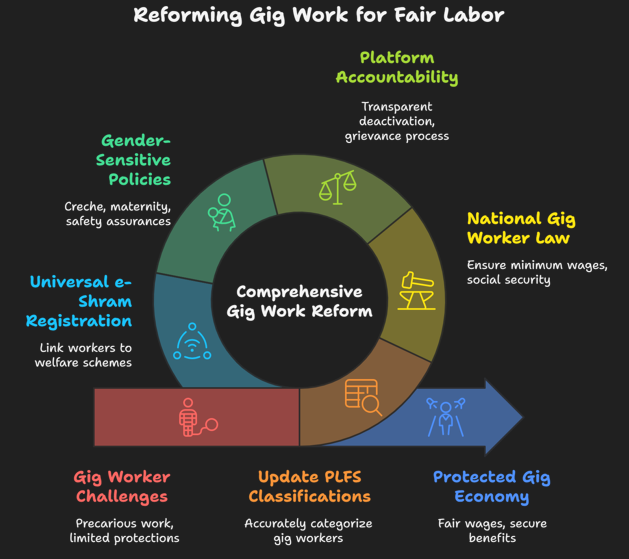
- Union Budget 2025: Included steps to formally recognise gig and platform workers.
- e-Shram portal: A digital national database for unorganised workers including gig workers.
- Digital ID cards and Ayushman Bharat: Health insurance benefits extended to some workers.
- Code on Social Security, 2020: Envisages creation of a Social Security Fund and the National Social Security Board for gig and platform workers.
What are the core challenges gig workers face in terms of social protection and labour rights?
- Lack of minimum wage guarantee
- No paid leave or health insurance
- Arbitrary deactivation by platforms
- High exposure to environmental hazards (e.g., during heatwaves)
- Algorithmic bias affecting earnings and visibility
- No collective bargaining rights
Their “flexibility” is euphemistic, hiding economic insecurity, unpredictability, and lack of labour protections.
How big is the gig economy in India and what are the projections?
- As per NITI Aayog (2022): The gig workforce will grow from ~7.7 million in 2020 to ~23.5 million by 2029-30.
- V.V. Giri National Labour Institute (2024): Gig workers are estimated to reach 23 million by 2030, constituting ~7% of the non-agricultural workforce.
Why is the classification of gig workers as “self-employed” problematic?
- It allows platforms to avoid employer liabilities.
- It masks the asymmetry of power—gig workers cannot negotiate terms.
- It denies access to benefits of formal employees.
- It leads to informalisation of formal-looking digital work.
How does the lack of labour data impact policymaking for gig workers?
- Welfare schemes become exclusionary.
- Budget allocations are misguided.
- Platform companies evade scrutiny.
- Workers’ vulnerabilities remain unaddressed.
Recognition without representation—where workers are acknowledged but not counted—is a policy failure.
How did Indian universities fare on the QS ranking list?
Indian Universities Achieve Major Breakthrough in QS World Rankings 2026
Context: For the first time, Indian universities have secured over 50 spots in the QS World University Rankings 2026, marking a significant rise from just 11 in 2015 to 54 institutions today.
What is the QS World University Rankings, and why is it significant?
- The QS World University Rankings, published annually by UK-based Quacquarelli Symonds, is one of the most respected global rankings for higher education institutions.
- It provides a comparative performance analysis of universities across the globe, influencing decisions of students, faculty, funders, and policymakers.
- The rankings are based on key indicators such as academic reputation, research output, employability, global engagement, and campus sustainability.
How did Indian universities perform in the QS World University Rankings 2026?
- What: In 2026, India secured 54 positions in the QS World University Rankings — its highest ever.
- Who: IIT Delhi emerged as India’s top-ranked institution, securing the 123rd rank, followed by IIT Bombay, IIT Madras, IIT Kharagpur, and IISc Bengaluru.
- Where: India is now the fourth most represented country, after the US (192), UK (90), and China (72).
- When: This performance comes as part of a steady rise — from just 11 ranked universities in 2015 to 54 in 2026, marking a five-fold increase.
- Why: The surge reflects increased emphasis on research, international collaboration, student outcomes, and alignment with global education standards.
Why are Indian universities rising in the QS rankings?
- Improved Research Culture: Traditionally, original research in India was concentrated in standalone research institutes. Now, IITs, IISERs, and private institutions are integrating research into their core academic mission.
- Policy Push via NEP 2020: The National Education Policy encourages interdisciplinary learning, research, and innovation, contributing to better performance in ranking metrics.
- Industry Linkages and Placements: Indian institutions like IIT Delhi (Rank 50 in Employer Reputation) and IIT Bombay (Rank 39) are scoring high in employer perception and student placements.
- Increasing Global Networks: International collaborations, faculty exchange, and global research partnerships are expanding — contributing to higher scores in the International Research Network.
- Campus Sustainability: Institutions are now focusing on green infrastructure and sustainable practices, which are now being quantified in rankings.
What challenges do Indian universities face in climbing higher in global rankings?
- Low International Diversity: Most Indian public universities lack foreign faculty and international students due to bureaucratic or financial barriers.
- Poor Faculty-Student Ratio: India’s average UG faculty-student ratio is 19:1, whereas international standards demand 10–15:1. (e.g., Ashoka has achieved 11.5:1)
- Limited Emphasis on Interdisciplinary Research: Despite progress, research often remains fragmented and underfunded in many institutions.
- Bureaucratic Hurdles: Administrative bottlenecks in public universities prevent quick adoption of reforms needed for internationalisation.
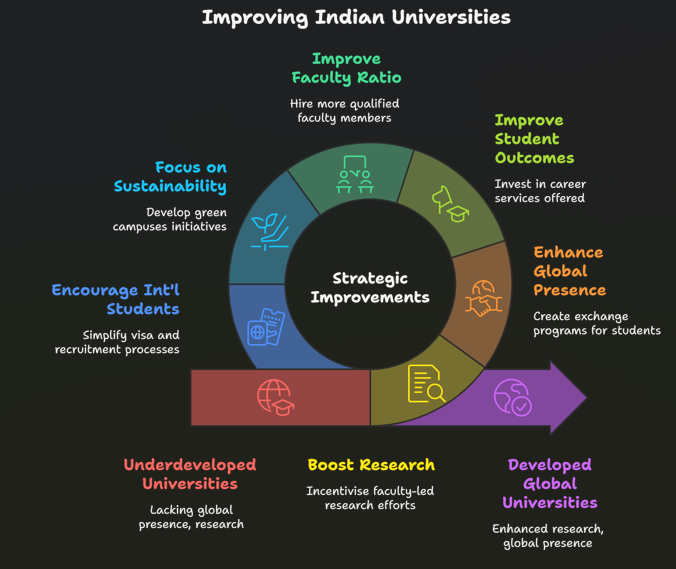
What is the broader significance of this trend for India’s education sector?
- The improvement signals that India is moving toward becoming a global education hub.
- With over 40% of Indians under 25, the education sector is central to India’s demographic dividend and knowledge economy.
- Achieving 50% Gross Enrolment Ratio (GER) by 2035 (as per NEP) requires building 14 new universities per week, as per QS estimates — implying the need for massive, rapid, and high-quality expansion.
BRICS to create a balanced multipolar world order
BRICS Drives Hope for a Balanced Multipolar World Order
Context: Prime Minister Narendra Modi is on a five-nation visit to Ghana, Trinidad and Tobago, Argentina, Brazil, and Namibia.
What is the objective of the visit?
When and where is the BRICS summit taking place?
The BRICS Summit 2025 is being held in Rio de Janeiro, Brazil, as part of Mr. Modi’s broader five-nation itinerary.
As of mid-2025, BRICS has expanded from 5 to 10 members, reflecting its increasing geopolitical and economic weight.
Current BRICS members: Brazil, Russia, India, China, South Africa, Argentina, Egypt, Ethiopia, Iran & United Arab Emirates (UAE).
- Strengthening South-South Cooperation with countries across Africa, Latin America, and the Caribbean.
- Attending the BRICS Summit in Brazil to advocate for a multipolar, equitable, and democratic world order.
- Expanding bilateral ties in areas such as : Investment, Vaccine manufacturing, Health and energy cooperation, Capacity building & Development partnerships
Why is Prime Minister Narendra Modi’s 2025 visit to BRICS nations significant?
His visit holds significance for the following reasons:
- Multilateral Diplomacy: To attend the BRICS summit and engage in discussions for a multipolar world order.
- Global South Engagement: Strengthening ties with key Global South nations across Africa, Latin America, and the Caribbean.
- Bilateral Cooperation: Enhancing investment, energy, health, capacity-building, and people-to-people ties in visited countries.

What does BRICS aim to achieve in today’s geopolitical context?
BRICS positions itself as a champion of a just, equitable, and democratic global order. Key objectives include:
- Multilateralism and Reform: Reforming global governance institutions like the UN, IMF, World Bank, and expanding developing countries’ voices.
- Economic Cooperation: Promoting intra-BRICS trade, which has crossed $1 trillion, and supporting infrastructure through the New Development Bank (NDB).
- De-dollarisation: Reducing dependence on the US dollar by conducting trade in local currencies and exploring alternatives to SWIFT.
- Sustainable Development: Supporting the 2030 Agenda and COP processes on climate, biodiversity, and desertification.
India’s Indigenous Dengue Vaccine, DengiAll
Dengue vaccine a step closer? India’s first phase 3 trial hits 50% enrolment mark, early data shows no safety concerns
Context: India has achieved a major milestone in the fight against dengue, reaching 50% enrolment in Phase III clinical trials for its indigenous tetravalent dengue vaccine, DengiAll. The vaccine shows promise in addressing a mosquito-borne viral disease with no specific treatment available to date.
What is DengiAll?
- DengiAll is India’s first indigenous tetravalent dengue vaccine, designed to protect against all four subtypes (DENV-1, DENV-2, DENV-3, DENV-4) of the dengue virus.
- Developed by Panacea Biotec Limited under a licensing agreement with the U.S. National Institutes of Health (NIH).
- It contains weakened forms of the four dengue virus strains, mirroring the NIH-developed vaccine’s virus composition, but with different inactive ingredients.
- A single-dose vaccine, DengiAll aims to offer broad and long-lasting protection against dengue, a mosquito-borne viral disease with no current specific treatment.
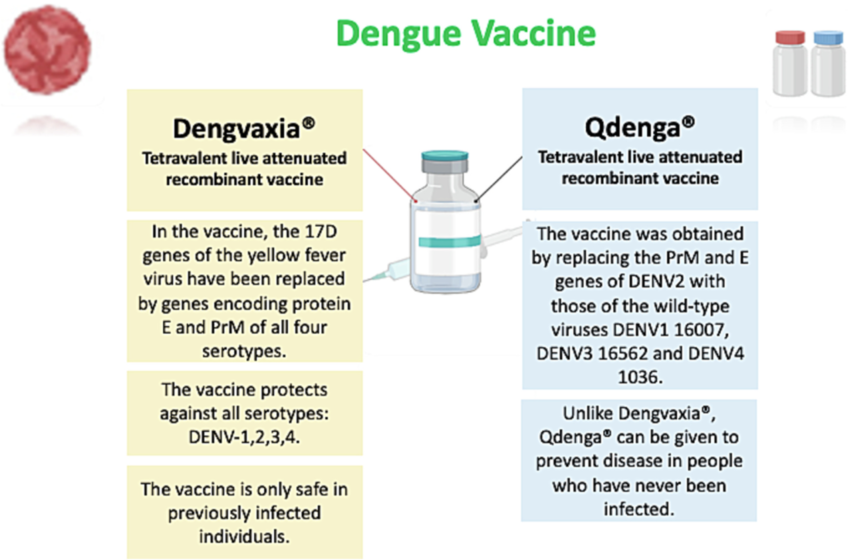
What Is Dengue Fever?
- Dengue is a viral disease transmitted to humans by the bite of infected Aedes mosquitoes, primarily Aedes aegypti.
- Symptoms typically appear 3–14 days after infection and may include: High fever (up to 104°F or 40°C), Severe headache and pain behind the eyes, Muscle and joint pain (“breakbone fever”), Nausea, vomiting, and rash.
- In some cases, dengue can progress to Dengue Hemorrhagic Fever (DHF) or Dengue Shock Syndrome (DSS). These can lead to internal bleeding, organ failure, and increased mortality risk.
- There is no specific treatment for dengue, so early diagnosis is important to give patients the right care and to help stop the disease from spreading.
India’s Dengue Burden:
- According to the World Health Organisation (WHO), dengue is one of the top 10 threats to global health, and India carries a significant share of the global dengue burden.
- The disease is endemic in many parts of the country, with seasonal outbreaks posing recurring threats to public health.
- Data from the National Centre for Vector Borne Diseases Control (Ministry of Health and Family Welfare) shows that by March 2025, over 12,000 dengue cases had already been reported. In 2024, the country saw a staggering 2.3 lakh (230,000) cases and 297 deaths attributed to dengue.
Why is This Vaccine Important?
- No Current Treatment for Dengue: Dengue can lead to severe complications (bleeding, plasma leakage, shock, and even death). This vaccine could prevent a disease with no cure, reducing severe cases and deaths.
- Indigenous Development Reduces Dependency: First made-in-India tetravalent dengue vaccine (unlike Sanofi’s Dengvaxia, which faced efficacy issues). Licensed from NIH, ensuring global scientific backing.
Kariyachalli Island
Tamil Nadu races to save sinking Kariyachalli island with 8,500 artificial reefs
Context: The Tamil Nadu government has launched an ambitious initiative to restore Kariyachalli Island under the Tamil Nadu Sustainably Harnessing Ocean Resources (TNSHORE) programme.
More on News
- This follows the successful restoration of Vaan Island, also part of the Gulf of Mannar, and is aimed at preventing the total submergence of Kariyachalli due to rapid erosion, rising sea levels, and coral reef degradation.
- The TNSHORE project, slated to begin in August 2025, will focus on reef restoration, seagrass bed planting, and the revival of marine biodiversity around the island.

What Is the Ecological Importance of Kariyachalli?
- Kariyachalli is one of 21 uninhabited low-lying islands in the Gulf of Mannar Marine National Park (GoMMNP), located on the southeastern coast of India between Rameswaram and Thoothukudi.
- The island belongs to the Thoothukudi group and lies 4 km south of Sippikulam and 20 km northeast of Thoothukudi Old Harbour.
- It hosts beaches, sand dunes, spits, and sandy plains, and is surrounded by coral reefs and seagrass beds that provide critical protection against erosion and support local fisheries.
- The Gulf of Mannar is one of four major coral reef areas in India and a hotspot of marine biodiversity, including endangered species like dugongs (sea cows). However, Kariyachalli’s future is under threat.
What Has Caused the Island’s Shrinking and Ecological Decline?
- Historical coral mining—particularly of boulder corals like Porites and Favia—led to the loss of reef-building structures and sediment suppliers. Though coral mining was banned in 2005, its long-term effects continue.
- According to a January 2025 report by IIT Madras’s Department of Ocean Engineering, the island’s landmass has shrunk by over 70% since 1969, decreasing from 20.85 hectares to under six hectares in 2024. At this pace of erosion, the island could be fully submerged by 2036 — just a decade away.
- Coral bleaching has affected around one-third of coral cover near the island, further reducing its ecological resilience.
The TNSHORE Restoration Plan
- Launched with support from the Tamil Nadu government and the World Bank, the restoration is being carried out by the Tamil Nadu Forest Department in collaboration with:
- IIT Madras Department of Ocean Engineering.
- Suganthi Devadason Marine Research Institute (SDMRI), Thoothukudi.
The project includes:
- Deployment of 8,500 multipurpose artificial reef modules:
-
- Made of ferrocement and steel, with perforated trapezoidal designs
- Height: 2–3 metres; Weight: 1.8–3 tonnes
- Purpose: Reduce wave energy, stabilise shorelines, and promote sediment deposition.
C-FLOOD Platform
Union Minister of Jal Shakti Shri C R Patil inaugurates C-FLOOD, a Unified Inundation Forecasting System
Context: The Union Minister of Jal Shakti, Shri C. R. Patil, inaugurated C-FLOOD, a Unified Inundation Forecasting System. The inauguration ceremony was held at Shram Shakti Bhawan, New Delhi.
What is C-FLOOD?
- C-FLOOD, a state-of-the-art Unified Inundation Forecasting System.
- It has been collaboratively developed by the Centre for Development of Advanced Computing (C-DAC), Pune and the Central Water Commission (CWC), under the aegis of the Department of Water Resources, River Development & Ganga Rejuvenation, Ministry of Jal Shakti.
- The initiative falls under the National Supercomputing Mission (NSM), which is jointly steered by the Ministry of Electronics and Information Technology (MeitY) and the Department of Science and Technology (DST).
Key Features:
- C-FLOOD employs advanced 2D hydrodynamic modelling to simulate flood scenarios.
- This cutting-edge web-based platform delivers two-day advance inundation forecasts at the village level, presenting detailed flood inundation maps and water level predictions.
- Designed as a unified system, C-FLOOD integrates flood modelling outputs from national and regional agencies, serving as a comprehensive decision-support tool for disaster management authorities.
Current Coverage: At present, the system covers Mahanadi, Godavari, and Tapi river basins, with plans to extend coverage to additional basins in the future.
- The Mahanadi Basin simulations are executed on the High Performance Computing (HPC) infrastructure under NSM at C-DAC Pune, while the Godavari and Tapi Basin outputs have been developed by the National Remote Sensing Centre (NRSC) under the National Hydrology Project (NHP).
Subscribe to our Youtube Channel for more Valuable Content – TheStudyias
Download the App to Subscribe to our Courses – Thestudyias
The Source’s Authority and Ownership of the Article is Claimed By THE STUDY IAS BY MANIKANT SINGH
